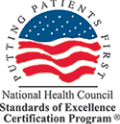By Robert A. Sandhaus, MD, PhD, FCCP and Bruce C. Trapnell, MD
Previously, we discussed vaccination against SARS-2 CoV, the virus causing the current global COVID-19 pandemic.1 This update is intended to provide further information on the value of community vaccination programs and the benefits and risks of COVID-19 vaccination, to assist you in making the best decisions for you and your family.
Why Vaccinate?
The history of vaccine use dates to more than 500 years when doctors in China would remove smallpox ‘scabs’ from one infected person, grind them into dust, and use this to vaccinate others against this deadly disease. In 1776, Dr. Edward Jenner discovered that prior infection by cowpox virus protected a person from subsequent infection by smallpox virus. These two viruses are similar and cause an ‘overlapping’ immune response, but smallpox infection causes a far more severe disease. In the 1800’s, smallpox was killing more than 400,000 people each year and causing blindness in one third of survivors. Today, smallpox has been virtually eliminated by vaccination – one of humanity’s greatest achievements.
Polio is another example of a devastating disease that maimed or killed millions of people that has been eliminated in the United States by mass vaccination (Figure). In 1952, Albert Sabin created a live attenuated (weakened) oral polio vaccine by growing the poliovirus in monkey cells. Oral administration of this vaccine caused a milder infection but prevented the vaccinated person from developing Polio upon subsequent exposure to the polio virus.
Today, we are fortunate to have vaccines that reduce death and disease caused by multiple viruses including smallpox, polio, chickenpox (varicella), Flu (Influenza), diphtheria, whooping cough, measles, meningococcus, haemophiles influenzae type B (Hib), pertussis (whooping cough), Rubella, Tetanus, Hepatitis A, Hepatitis B, Mumps, Pneumococcus, Rotavirus, and others. It is important we remind ourselves of these historical triumphs of science and medicine since current and future generations may have little or no awareness of the death and devastation these viruses cause because they have never seen anyone affected by one of them.
How Viruses Work
While there are many accounts of how vaccines work, a summary is useful before considering vaccine types and the risks and benefits of vaccination. Briefly, vaccines work by preparing a person’s immune system to seek out, recognize, and destroy a microbe (for example, a virus). Vaccination ‘educates’ the immune system to recognize the virus like a key fits (recognizes) into its matching lock. The ‘immune response’ involves various types of immune cells, cytokines (signaling molecules), and antibodies (immune proteins manufactured to specifically recognize the virus). Antibodies bind to and help other immune cells remove virus particles and immune cells help remove cells that become infected by the virus to which they are ‘educated’ to recognize. Sometimes, antibodies bind to an important part of the virus particle, which prevents it from entering and infecting the cell.
Vaccine Types
A wide variety of vaccines have been developed throughout history including administration of:
1. Virus-infected tissues (i.e., ground up Smallpox scabs)
2. A similar but less severe virus (i.e., Cowpox for Smallpox)
3. Attenuated (weakened) live virus (i.e., influenza)
4. Inactivated (killed) virus
5. Purified (or laboratory produced) components of the germ (i.e., tetanus toxin)
6. Expression of one gene from the virus (by several methods)
Risks and Benefits of Vaccination
While the benefits of vaccination are similar across vaccine types, potential risks vary with the type of vaccine and sometimes with the health of the person to be vaccinated. For example, attenuated (weakened) live virus vaccines are designed to produce a mild infection in healthy individuals; however, in someone with immune deficiency, an attenuated virus vaccine can cause severe infection. Thus, live vaccines are not recommended in people with immune deficiency. Inactivated virus vaccines, which are composed of many immune ‘recognition targets’ cause a complex immune response which in a small number of people can result in attack on non-infected cells. An example of this is Guillain Barre syndrome, a transient but important neurological problem. This type of problem is referred to as ‘immunological cross-over’ response. Vaccines based on expression of a single viral gene represent a substantial improvement in the risk-benefit ratio as described below.
COVID-19 and Vaccines
Infection of cells by the SARS-CoV-2 virus begins with attachment of the spike protein to a specific cell-surface receptor. Programed changes in the spike protein bring the virus close to the cell and cause entry of the viral chromosome into the cell. Once inside, the viral RNA chromosome is used to manufacture many thousands of copies of the virus that infect other cells. For SARS-CoV-2, this process occurs preferentially in the airways and lungs and can result in a severe and deadly host inflammatory response, which occurs in the lungs initially but can extend to the entire body.
Four decades on gene therapy research have resulted in improved vaccinations methods. Now, instead of grinding up scabs from infected people, infection by a similar virus, or injection of inactivated virus, it is possible to isolate a single viral gene – for example, the ‘spike’ protein of SARS-Cov-2, which is critical for entry of the virus into a cell. This gene can be injected directly and used by cells to manufacture only one viral protein, which has the advantage of limiting the vaccination person’s immune response to one part of the virus that is critical for infection. This focused response simultaneously blocks the infection and limits potential for unwanted immune response.
All COVID-19 vaccines currently fully approved by the FDA for use in the US involve expression of only one viral gene (the spike protein) and cause a sharply focused immune attack on this critical protein. Consequently, it is not possible to develop COVID-19 from the vaccine. These vaccines also do not affect our genes or the ability to become pregnant. A full discussion of COVID-19 vaccination ‘myths’ by the team at John’s Hopkins is available online. The two most used COVID-19 vaccines (from Pfizer and Moderna) require two injections given several weeks apart. The CDC has now recommended the use of a third ‘booster’ shot to improve the protection. Vaccination can result in minor discomfort, redness, and swelling can occur at the injection site and systemic symptoms such as feeling unwell, feverish, fatigued, and/or achy; however, these are signs of effective vaccination. Concerns about COVID-19 vaccination include a range of potential side effects and long-term consequences.
However, all of the currently available vaccines effectively prevent severe infection, hospitalization, and death from COVID-19. Notwithstanding side effects in a very small portion of vaccinated people, the benefits of vaccination to the individual being and their community far outweigh the risks. We also know individuals with Alpha-1 have no greater risk of vaccine-related side effects than the general public. Put plainly, the risk of serious disease or death from COVID-19 in the unvaccinated is far greater than the risk of side effects from the vaccine itself. Further, reducing the number of people who are infected is anticipated to reduce the frequency of emergence of novel viral mutants, such as the Delta and Omicron variants. In summary, COVID-19 vaccination is recommended for all eligible individuals including people who have received lung transplantation.











